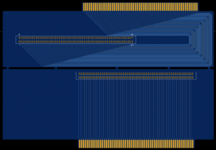warmech
Well-known member
@stepleton Instead of IDE cables, how do you think these may fair as far as avoiding interference? The CPU riser is pretty simple, but the I/O riser inverts the connector to allow the card to have its component side face up for easier diagnostic access. I know that's a lot of traces to invert that connector, but do you think it might fare better than 120 wires running a foot or so? The power rails on both are .254mm as well; think that might cause some issues with draw, or would that be more negligible than I'm thinking?
Edit: Earlier I said these would have to be used with the fiberglass cage removed but, after some testing, these should drop into the motherboard's CPU and I/O connectors with the cage attached. This will allow them to maintain a good deal of stability by using the cage's rails to hold them upright. There's enough space at the back of the cage for both of these to seat into the motherboard and connect both cards (with about a +/- 1mm shortfall for the CPU card - not enough to matter, thankfully). The amount of space at the back of the cage is oddly close to perfect for these, which makes me wonder if Apple had a similar setup for diagnosing/repairing Lisa cards. I'll probably add some space between the topmost trace on the I/O riser and the edge of the card; it looks a bit close at the moment.
Edit 2: Because I overthink everything, the I/O card can obviously be worked on in the cage be default without need for anything like this. If you wanted to work on the CPU card, however, you'd have to fold the I/O card over in order to use the CPU riser.


Edit: Earlier I said these would have to be used with the fiberglass cage removed but, after some testing, these should drop into the motherboard's CPU and I/O connectors with the cage attached. This will allow them to maintain a good deal of stability by using the cage's rails to hold them upright. There's enough space at the back of the cage for both of these to seat into the motherboard and connect both cards (with about a +/- 1mm shortfall for the CPU card - not enough to matter, thankfully). The amount of space at the back of the cage is oddly close to perfect for these, which makes me wonder if Apple had a similar setup for diagnosing/repairing Lisa cards. I'll probably add some space between the topmost trace on the I/O riser and the edge of the card; it looks a bit close at the moment.
Edit 2: Because I overthink everything, the I/O card can obviously be worked on in the cage be default without need for anything like this. If you wanted to work on the CPU card, however, you'd have to fold the I/O card over in order to use the CPU riser.


Last edited:




